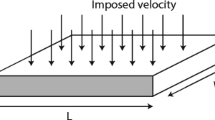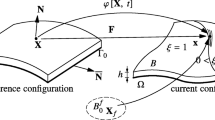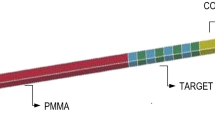Abstract
Nowadays thermoplastic composite materials are more and more used due to their specific excellent mechanical properties and a good recyclability. However, many difficulties are encountered during their forming processes, specially in the case of thermoplastic composites –TPC–. Therefore, consolidation of thermoplastic composites is becoming one of the most active research topics in composite manufacturing. Many processes proceed by heating prepregs to melt the polymer, then apply a compression in order to remove residual porosity trapped at the layers interfaces and consolidate the material. Thus the different layers containing the molten thermoplastic resin are compressed and squeeze flow occurs. Even if some modeling has been addressed, the flow occurring in the laminate, inside the yarns and in between the yarns requires rich 3D numerical descriptions with a fine enough description of the complex kinematics taking place in the laminate thickness. In this work we analyze the limits of lubrication based descriptions, justifying the necessity of proceeding with 3D descriptions. In order to alleviate the cost that such simulations involve, we employ an advanced discretization technique making use of an efficient in-plane-out-of-plane separated representation of the different fields involved in the model. Thus very fine descriptions are possible with a computational cost characteristic of 2D descriptions, as the ones making use of the lubrication hypotheses.









Similar content being viewed by others
References
Adams MJ, Edmondson B, Caughey DG, Yahya R (1994) An experimental and theoretical study of the squeeze-film deformation and flow elastoplastic fluids. J Non-Newtonian Fluid Mech 51(1):61–78
Ammar A, Mokdad B, Chinesta F, Keunings R (2006) A new family of solvers for some classes of multidimensional partial differential equations encountered in kinetic theory modeling of complex fluids. J Non-Newtonian Fluid Mech 139:153–176
Barone MR, Caulk DA (1985) Kinematics of flow in sheet moulding compounds. Polym Compos 6(2):105–109
Barone MR, Osswald TA (1987) Boundary integral equations for analyzing the flow of a chopped fiber reinforced polymer compound in compression molding. J Non-Newtonian Fluid Mech 26:185–206
Bognet B, Leygue A, Chinesta F, Poitou A, Bordeu F (2012) Advanced simulation of models defined in plate geometries:3D solutions with 2D computational complexity. Comput Methods Appl Mech Eng 201:1–12
Chinesta F, Ammar A, Cueto E (2010) Recent advances and new challenges in the use of the Proper Generalized Decomposition for solving multidimensional models. Arch Comput Methods Eng 17:327–350
Chinesta F, Ladeveze P, Cueto E (2011) A short review in model order reduction based on Proper Generalized Decomposition. Arch Comput Methods Eng 18:395–404
Chinesta F, Ammar A, Leygue A, Keunings R (2011) An overview of the Proper Generalized Decomposition with applications in computational rheology. J Non-Newtonian Fluid Mech 166:578–592
Chinesta F, Leygue A, Bognet B, Ghnatios C, Poulhaon F, Bordeu F, Barasinski A, Poitou A, Chatel S, Maison-Le-Poec SFirst steps towards an advanced simulation of composites manufacturing by automated tape placement. Int J Mater Form. http://www.springerlink.com/index/10.1007/s12289-012-1112-9
Chinesta F, Leygue A, Bordeu F, Aguado JV, Cueto E, Gonzalez D, Alfaro I, Ammar A, Huerta A (2013) PGD-based computational vademecum for efficient design, optimization and control. Arch Comput Methods Eng 20:31–59
Engmann J, Servais C, Burbidge AS (2005) Squeeze flow theory and applications to rheometry:A review. J Non-Newtonian Fluid Mech 132:1–27
Gibson AG, Toll S (1999) Mechanics of the squeeze flow of planar fibre suspensions. J Non-Newtonian Fluid Mech 82(1):1–24
Kalyon DM, Tang HS (2007) Inverse problem solution of squeeze flow for parameters of generalized newtonian fluid and wall slip. J Non-Newtonian Fluid Mech 143:133–140
Kotsikos G, Gibson AG (1998) Investigating the squeeze flow behavior of sheet moulding compounds (SMC). Compos Part A 29A:1569–1577
Lee CC, Folgar F, Tucker CL (1984) Simulation of compression moulding for fiber-reinforced thermosetting polymers. Trans of ASME 106:114–125
Lee LJ, Marker LF, Griffith RM (1981) The rheology and mould flow of polyester SMC. Polym Compos 2(4):209–218
Lian G, Xu Y, Huang W, Adams MJ (2001) On the squeeze flow of a power-law fluid between rigid spheres. J Non-Newtonian Fluid Mech 100:151–164
Servais C, Luciani A, Manson JAE (2002) Squeeze flow of concentrated long fiber suspensions :experiments and model. J Non-Newtonian Fluid Mech 104:165–184
Sherwood JD (2011) Squeeze flow of a power-law fluid between non-parallel plates. J Non-Newtonian Fluid Mech 166:289–296
Shuler SF, Advani SG (1996) Transverse squeeze flow of concentrated aligned fibers in viscous fluids. J Non-Newtonian Fluid Mech 65:47–74
Silva-Nieto RJ, Fisher BC, Birley AW (1981) Rheological characterization of unsaturated polyester resin SMC. Polym Eng Sci 21(8):499–506
Zhang W, Silvi N, Vlachopoulos J (1995) Modelling and experiments of squeezing flow of polymer melts. Int Polym Process 10:155–164
Author information
Authors and Affiliations
Corresponding author
Appendices
Appendix A: Monolayer squeeze flow of a Newtonian resin
We consider a layer of a Newtonian fluid characterized by a viscosity η filling the domain Ξ = Ω × ℐ, where Ω ⊂ ℛ 2 and ℐ = [−h/2, h/2] ⊂ ℛ. The domain thickness h is assumed small enough (with respect to the in-plane characteristic dimensions) and it is assumed constant.
The Stokes’s equations for an incompressible Newtonian fluid read:
where v is the velocity vector with components v = (u, v, w) and p the pressure field. Eq. 28 results in the following three scalar equations:
When the layer thickness is much lower than the characteristics in-plane dimensions involved in Ω the following hypotheses (known as lubrication hypotheses) apply:
reducing the Stokes’s equations (29) to:
Now, by integrating Eq. 31 with respect to z and taking into account that p = p(x) = p(x, y) as well as the non-slip boundary conditions
it results:
that integrated in the thickness allows calculating the flow rates q x and q y
The mass conservation, taking into account the fluid incompressibility and the compression rate ḣ, reads:
or more explicitly:
that allows deriving the equation related to the pressure field:
that when the thickness is the same everywhere reduces to:
B: Monolayer squeeze flow of a power-law resin
In order to address a more complex resin rheology we consider it described by the power law constitutive equation
where K and n are two material parameters, D the strain rate tensor and D eq the equivalent strain rate
where ” : ” denotes the tensor product twice contracted.
Now, the momentum balance writes
Within the lubrication framework the equivalent strain reduces to
with p = p(x). By integrating Eq. 41 in the z-coordinate and taking into account that the velocity derivatives vanish at z = 0 because the flow symmetry with respect to the mid-plane, it results
By taking the square of both equalities in Eq. 43 and then adding both (taking into account Eq. 42) it results
By introducing Eq. (44) into Eq. 43, integrating again in the layer thickness ℐ and considering the non-sliping condition at z = h/2 (or z = − h/2) it finally results:
with
Now, the flow rate q can be computed by using Eq. 34 and the mass balance enforced
that results in a second order non-linear partial differential equation that allows computing the 2D pressure. Knowing the pressure field, the velocity can be obtained from Eq. 45.
Rights and permissions
About this article
Cite this article
Ghnatios, C., Chinesta, F. & Binetruy, C. 3D Modeling of squeeze flows occurring in composite laminates. Int J Mater Form 8, 73–83 (2015). https://doi.org/10.1007/s12289-013-1149-4
Received:
Accepted:
Published:
Issue Date:
DOI: https://doi.org/10.1007/s12289-013-1149-4




